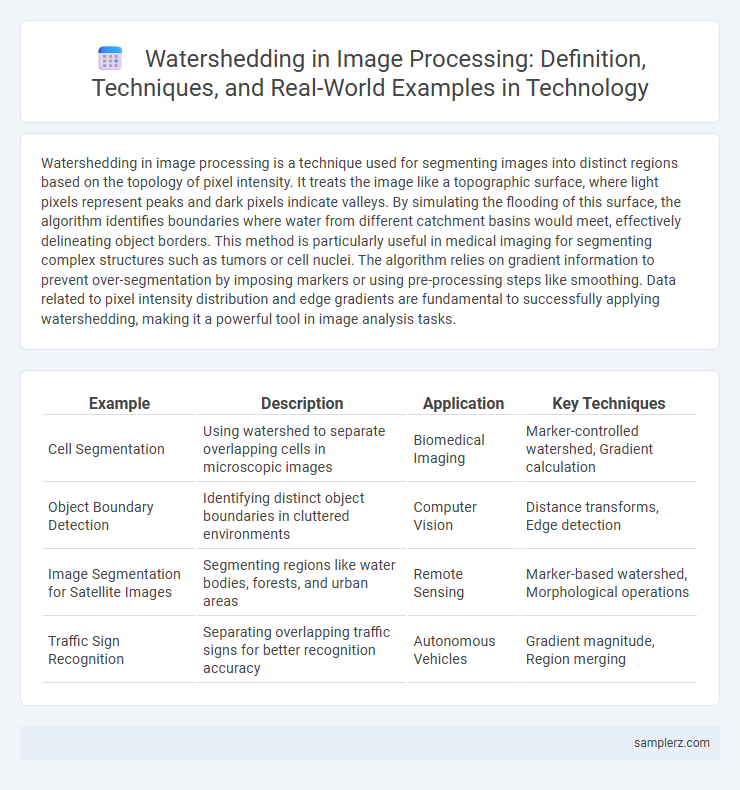Watershedding in image processing is a technique used for segmenting images into distinct regions based on the topology of pixel intensity. It treats the image like a topographic surface, where light pixels represent peaks and dark pixels indicate valleys. By simulating the flooding of this surface, the algorithm identifies boundaries where water from different catchment basins would meet, effectively delineating object borders. This method is particularly useful in medical imaging for segmenting complex structures such as tumors or cell nuclei. The algorithm relies on gradient information to prevent over-segmentation by imposing markers or using pre-processing steps like smoothing. Data related to pixel intensity distribution and edge gradients are fundamental to successfully applying watershedding, making it a powerful tool in image analysis tasks.
Table of Comparison
| Example | Description | Application | Key Techniques |
|---|---|---|---|
| Cell Segmentation | Using watershed to separate overlapping cells in microscopic images | Biomedical Imaging | Marker-controlled watershed, Gradient calculation |
| Object Boundary Detection | Identifying distinct object boundaries in cluttered environments | Computer Vision | Distance transforms, Edge detection |
| Image Segmentation for Satellite Images | Segmenting regions like water bodies, forests, and urban areas | Remote Sensing | Marker-based watershed, Morphological operations |
| Traffic Sign Recognition | Separating overlapping traffic signs for better recognition accuracy | Autonomous Vehicles | Gradient magnitude, Region merging |
Introduction to Watershedding in Image Processing
Watershedding in image processing is a powerful segmentation technique that treats pixel intensity as topographical elevation to delineate object boundaries. By simulating water flooding from local minima, watershed algorithms effectively separate overlapping features in complex images. This approach is widely used in medical imaging, computer vision, and pattern recognition for precise object extraction.
Key Concepts Behind the Watershedding Algorithm
The watershedding algorithm in image processing segments regions by treating grayscale images as topographic surfaces, where pixel intensities represent elevations. Key concepts include identifying markers or seeds, which serve as sources of flooding, and simulating water rising to partition basins separated by watershed lines. This method effectively isolates objects and boundaries by exploiting gradients and local minima within the image.
Common Applications of Watershedding Techniques
Watershedding techniques in image processing are widely used for segmenting complex images, particularly in medical imaging to delineate tumors and anatomical structures. These methods enhance object boundary detection in satellite imagery and improve quality control in industrial vision systems by accurately separating overlapping objects. Watershedding also facilitates image analysis in biometrics, such as fingerprint recognition, by precisely extracting ridge patterns.
Step-by-Step Example of Watershed Segmentation
Watershed segmentation in image processing begins by identifying regional minima in the grayscale image, which represent catchment basins. Markers are then placed inside these basins to initiate flooding, simulating water rising and merging at watershed lines. The algorithm proceeds by gradually increasing the water level, assigning pixels to basins based on gradient intensity, resulting in precise boundary delineation between adjacent objects.
Watershed Transform for Edge Detection Tasks
Watershed Transform in image processing segments adjacent regions by treating grayscale images as topographic surfaces, where water droplets flood catchment basins to detect edges effectively. This technique excels in identifying object boundaries and separating overlapping structures by finding watershed lines corresponding to ridge lines between regions. It is widely used in medical imaging, remote sensing, and microscopy for precise edge detection and image segmentation tasks.
Comparing Watershedding with Other Segmentation Methods
Watershedding in image processing excels in accurately segmenting objects with irregular boundaries by treating grayscale intensities as topographic surfaces, which often produces clearer edge delineation compared to thresholding or region growing methods. Unlike clustering algorithms like K-means that may struggle with spatial coherency, watershedding leverages gradient information to separate adjacent objects effectively, reducing over-segmentation risks. This technique is especially advantageous in medical imaging and materials science where precision in boundary detection directly impacts analysis quality.
Case Study: Watershedding in Medical Image Analysis
Watershedding in medical image analysis is crucial for segmenting complex structures such as tumors and organs in MRI and CT scans. This technique enhances the accuracy of boundary detection by treating pixel intensity gradients as topographical surfaces, enabling precise delineation of anatomical features. Case studies demonstrate improved diagnostic outcomes through automated identification of pathological regions, facilitating targeted treatment planning and monitoring.
Challenges and Limitations of Watershedding
Watershedding in image processing faces challenges such as over-segmentation due to noise and texture variations, making it difficult to accurately delineate object boundaries. The algorithm's sensitivity to input markers often results in fragmented regions when proper markers are not defined, limiting its robustness in complex scenes. Computational cost and difficulty handling overlapping or blurred edges further constrain its practical applications in real-time systems.
Enhancing Watershedding Results with Marker-Based Methods
Marker-based watershedding enhances image segmentation accuracy by incorporating predefined markers that guide the watershed transform, effectively reducing over-segmentation. This method uses internal and external markers derived from morphological operations or prior knowledge to precisely localize object boundaries. Integrating marker-based watershedding with gradient information maximizes edge detection, improving the delineation of complex structures in medical imaging and computer vision tasks.
Future Trends in Watershedding Image Processing
Emerging advancements in watershedding image processing harness deep learning algorithms to enhance segmentation accuracy and computational efficiency, enabling precise delineation of complex image regions. Integration of quantum computing techniques promises exponential speed-ups in processing large-scale images, revolutionizing real-time applications in medical imaging and autonomous systems. Research in adaptive watershedding methods driven by artificial intelligence is expected to optimize noise resilience and boundary detection, setting new benchmarks for image analysis in diverse technological fields.

example of watershedding in image processing Infographic
 samplerz.com
samplerz.com